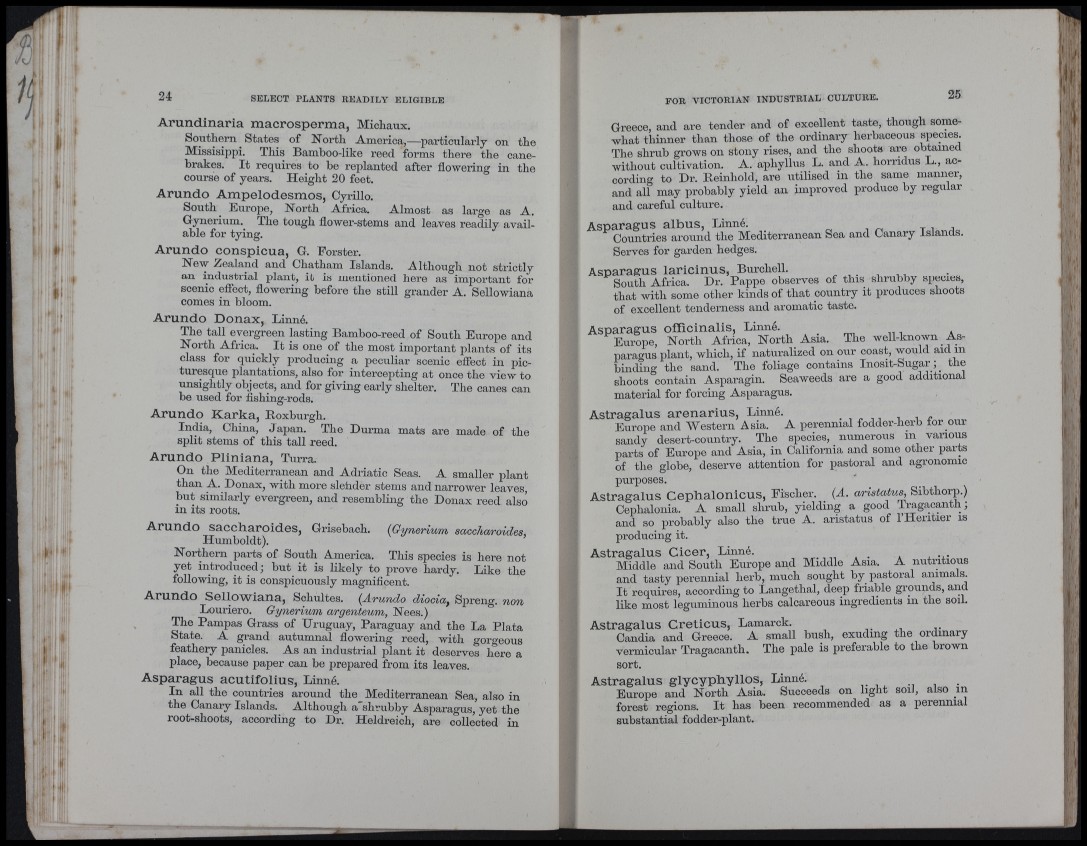
j !
i ■
I
i:;
I
, lit
■* • f\
ii : 4’ •
■ ' \r
‘I :
'4
I
! :;; i
' u i l '
. . i h ;
) !
Arundinaria macrosperma, Michaux.
Southern States of North America,—particularly on the
Missisippi. This Bamboo-like reed forms there the cane-
brakes. I t requires to be replanted after flowering in the
course of years. Height 20 feet.
Arundo Ampelodesmos, Cyrillo.
South _ Europe, North Africa. Almost as large as A.
Gynerium. The tough flower-stems and leaves readily available
for tying.
Arundo conspicua, G. Forster.
New Zealand and Cliatham Islands. Although not strictly
an industrial plant, it is mentioned here as important for
scenic effect, flowering before the still grander A. Sellowiana
comes in bloom.
Arundo Donax, Linné.
The tall evergreen lasting Bamboo-reed of South Europe and
North Africa. I t is one of the most important plants of its
class for quickly producing a peculiar scenic effect in picturesque
plantations, also for intercepting at once the view to
unsightly objects, and for giving early shelter. The canes can
be used for fishing-rods.
Arundo Karka, Eoxburgh.
India, China, Japan. The Durma mats are made of the
split stems of this tall reed.
Arundo Pliniana, Turra.
On the Mediterranean and Adriatic Seas. A smaller plant
than A. Donax, with more slehder stems and narrower leaves,
but similarly evergreen, and resembling the Donax reed also
in its roots.
Arundo saccharoides, Grisebach. {Gynerium saccharoides,
Humboldt).
Northern parts of South America. This species is here not
yet introduced; but it is likely to prove hardy. Like the
following, it is cons]xicuously magniflcent.
Arundo Sellowiana, Schultes. {Arundo diocia, Spreng. non
Louriero. Gynerium argenteum, Nees.)
The Pampas Grass of Uruguay, Paraguay and the La Plata
State. A grand autumnal flowering reed, with gorgeous
feathery panicles. As an industrial plant it deserves Imre a
place, because paper can be prepared from its leaves.
Asparagus acutifolius, Linné.
In all the countries around the Mediterranean Sea, also in
the Canary Islands. Although a"shrubby Asparagus, yet the
root-shoots, according to Dr. Heldreich, are collected in
Greece, and are tender and of excellent taste, though somewhat
thinner than those of the ordinary herbaceous species.
The sbrub grows on stony rises, and the slioots are obtained
without cultivation. A. apbyllus L. and A. liorridus L., according
to Dr. Eeinliold, are utilised in the same manner,
and all may probably yield an improved produce by regular
and careful culture.
Asparagus albus, Linné. t i i
Countries around the Mediterranean Sea and Canary Islands.
Serves for garden hedges.
Asparagus laricinus, Burchell.
South Africa. Dr. Pappe observes of this shrubby species,
that with some other kinds of that oeiintry it produces shoots
of excellent tenderness and aromatic taste.
Asparagus officinalis, Linné.
Europe, North Africa, North Asia. The well-known Asparagus
plant, which, if naturalized on our coast, would aid in
binding the sand. The foliage contains Inosit-Sugar ; _ the
shoots contain Asparagin. Seaweeds are a good additional
material for forcing Asparagus.
Astragalus arenarius, Linné. . , ^ i .
Europe and Western Asia. A perennial fodder-herb for onr
sandy desert-country. The species, numerous in various
parts of Europe and Asia, in California and some other parts
of tlie globe, deserve attention for pastoral and agronomic
purposes.
Astragalus Cepbalonicus, Eiscber. {A. aristatus, Sibtborp.)
Cephalonia. A small shrub, yielding a good Tragacantli;
and so probably also the true A. aristatus of 1 Héritier is
producing it.
Astragalus Cicer, Linné. ____
Middle and South Europe and Middle Asia. A nutritions
and tasty perennial herb, much sought by pastoral animals.
I t requires, according to Langethal, deep friable grounds, and
like most leguminous herbs calcareous ingredients in the soil.
Astragalus Creticus, Lamarck.
Candia and Greece. A small bush, exuding the ordinary
vermicular Tragacanth. The pale is preferable to the brown
sort.
Astragalus g ly cyp b y llo s, Linné. .
Europe and North Asia. Succeeds on light soiJ, also in
forest regions. I t has been recommended as a perennial
substantial fodder-plant.
' !
I1 . I
iâ
' 'it'